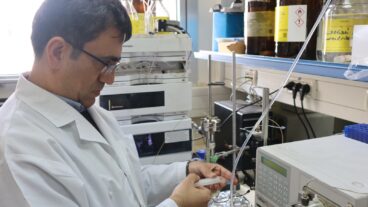Israel’s Hepatitis A vaccination program has lowered the incidence of the disease by 95 percent, and is quickly becoming a model for other countries interested in eliminating the disease.When Israeli epidemiologists decided to take a radical new approach to fighting Hepatitis A three years ago, they knew it was a gamble.
But their decision to make Israel the first nation in the world to offer free vaccinations to all of its toddlers against the virus has paid off tremendously, with a stunning drop in the incidence of the disease across the country
With the success of its vaccination program that has lowered the incidence of the disease by 95 percent, the unique program is quickly becoming a model for other countries interested in eliminating the disease.
The results of a comprehensive study of the Israeli immunization program was pubished in the July 13 issue of the prestigious Journal of the American Medical Association.
Hepatitis A is a liver disease caused by the Hepatitis A virus. Until 1999, there was a relatively high rate of incidence in Israel of the disease for a developed country – somewhere between five to fifteen percent more frequent per capita than in the United States, with a markedly higher rate among lower socioeconomic groups.
According to statistics for the period of 1992-1998, between 33 and 70 people per 100,000 population became infected with Hepatitis A. In general, the disease is costly to the health care system as well as the workplace, as those infected become too tired and ill to function. In the worst cases, a liver transplant is required to save the lives of those with the disease.
Dr. Ron Dagan, of Ben-Gurion University of the Negev, who along with colleagues was in charge of combating the proliferation of the disease, decided to come up with a new strategy to fight it.
“In the United States, the policy for fighting hepatitis A has been going to regions and states where there is a high incidence of the disease, and vaccinate all children under six,” Dagan told ISRAEL21c. “This is very laborious way to approach the problem and demands high level of resources. In Israel, we were faced with both a more urgent problem – the higher incidence but also far more limited resources.”
Dagan and his fellow epidemiologists brainstormed on how they could expend their limited budget for vaccination with the greatest effectiveness.
Hepatitis A virus is spread from person to person by putting something in the mouth that has been contaminated with the stool of a person with hepatitis A. For this reason, the virus is more easily spread in areas where there are poor sanitary conditions or where good personal hygiene is not observed.
Most infections result from contact with a household member or partner who has hepatitis A. Casual contact, as in the office, factory, or school setting, does not spread the virus.
Dagan’s team decided to focus on the particularly high potential for transmission among the small children who attend day care centers, nursery schools and kindergartens.
We thought if we understand the disease and how it is transmitted, we could attack it strategically. We came to believe very strongly that it was primarily transmitted though very small children. They’re a group that both come into contact with wider society through day care centers, and don’t behave in a hygienic fashion they touch everything, put things in their mouths. We began to believe that many of them would get infected, transmit the disease through their dishes, toys and diapers for several weeks before they began to show symptoms and it became clear that they were infected.”
People with Hepatitis A virus infection may not have any signs or symptoms of the disease, particularly if they are young. Older people are more likely to have symptoms than children. If symptoms are present, they usually occur abruptly and may include fever, tiredness, loss of appetite, nausea, abdominal discomfort, dark urine, and jaundice, the yellowing of the skin and eyes.
According to The Jerusalem Post, the idea to vaccinate all infants against Hepatitis A in an effort to protect not only children but also the adults who come in contact with them was first raised and tested by Prof. Daniel Shouval, head of the liver unit at Hadassah Medical Center in Jerusalem. Nearly a decade ago he was summoned by the Satmar Hassidim in Monsey, New York, in response to an epidemic of the disease. The Monsey program was successful and he recommended that Israel adopt a similar one.
Vaccinating all toddlers in Israel began to look like a strategy with great potential the idea being that doing so would eliminate a major source of infection for other children and adults, and eventually prevent infections in older persons as vaccinated children grow to adulthood, because immunity to hepatitis A virus by vaccination is long-lasting.
“We thought that if we vaccinate all of the children at toddler age, we could protect them, and everyone around them. So we took one age group of toddlers beginning in July of 1999 and began vaccinating them free of charge. We didn’t bother doing catch-up vaccinations for those born before 1998. We managed to vaccinate 90 percent for the first dose of vaccine at age 18 months, and 85 percent in the second dose at age 24 months,” said Dagan.
The idea didn’t come without opposition. “We had a big debate at the national advisory board as to whether this approach was wise. I was a believer, along with a majority. I think that everybody knew that it would work but it was a question of how fast it would work,” he added.
The program turned out to be effective more quickly than they could have imagined.
“In just three years, we dropped the incidence rate [per capita] below that in the US. From 2002, we have had a historically low rate, with 150 cases per year. This year, there were no liver transplants or hospitalizations due to hepatitis. This is amazing.”
There also hasn’t been a single hepatitis A related death in Israel since 2002. Dagan noted that even though a lower percentage of Israeli Arab children were vaccinated than Jewish children, the number of these children who were infected also dropped dramatically.
According to Dagan, other countries that are fighting high rates of hepatitis A are paying attention to the events in Israel.
“Several Latin America countries – Chile, Argentina, and are consulting with us and are debating whether to introduce the vaccine the same way. Our paradigm has taught people that there exists a very efficient method to specifically target the population who spreads the virus.”
Whether such a program would be cost-effective in the United States will also be examined. An estimated 270,000 Americans contracted hepatitis A annually during the 1980s and 1990s. In 1995, effective vaccines for the disease became available, and the US government’s Center for Disease Control initially recommended vaccination only for people in high-risk groups, such as drug users, gay men and people traveling to areas where hepatitis A outbreaks are common. In 1999, those recommendations were expanded to include children living in US states with high rates of infection.
In an editorial published alongside the JAMA article on the Israeli achievement, Pierre Van Damme, M.D., Ph.D., and Koen Van Herck, M.D., of the University of Antwerp, Belgium endorsed the idea of using the Israeli strategy as a model, writing that, “if administration of multiple vaccines or combination vaccines is not an issue, and if the vaccine cost is reasonable, toddlers-only or childhood immunization programs could become a realistic strategy in countries and regions where endemicity is shifting from high to intermediate, a situation that will increase in the next decade worldwide.”
Dagan believes that in the future, the idea of focusing on toddlers may apply to other diseases as well.












